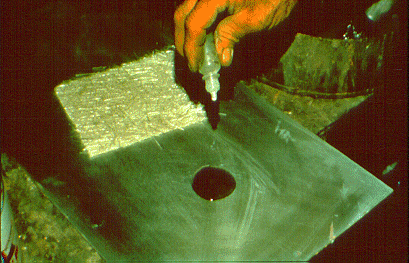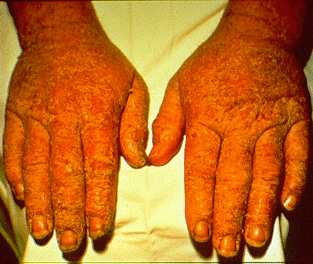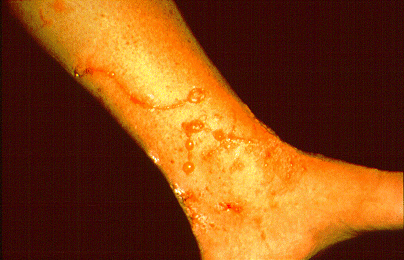Occupational Dermatoses
NOTE: This page is archived for historical purposes and is no longer being maintained or updated.
Slides 46 to 50
Slide 46 - Polyester

Allergic contact dermatitis can result from the process of mixing polyester resin and catalyst in body-fender work. The article being glued is fibrous glass.
Slide 47 - Chromium

In the United States, all cement contains chromium. Allergic sensitivity to dichromate is often associated with a cement dermatitis. In such cases the primary irritant action of the alkali plus the abrasive and hygroscopoc properties of cement precede and favor sensitization by the chrome salts.
Slide 48 - Chemical Accelerators in Rubber

Allergic contact dermatitis due to rubber chmicals is fairly common in industry. Chemial accelerators that speed up the vulcanization raction and antixidants are the more frequent allergens. They present a potential hazard in finishing goods as well.
Slide 49 - Poison ivy

The Rhus genus of plants include poison ivy, poison oak and poison sumac. These plants pose a significant occupational problem to a diverse group of workers in highway maintenance, construction, utilities, agriculture and other occupations with outdoor exposures. Poison ivy dermatitis may even be acquired from the smoke burning plants.
Slide 50 - Airborne chrysanthemum
This photo was removed due to privacy concerns.
Repeated exposure to relatively small amounts of airborne allergens can cause dermatitis at points of contact, as shown in this example of dermatitis in a florist due to chrysanthemums. Airborne patterns tend to involve the wrinkles and folds of the exposed body areas. Many of the common allergens are pollens and dusts.
- Page last reviewed: January 5, 1998 (archived document)
- Content source:
- National Institute for Occupational Safety and Health Health Effects Laboratory Division (HELD)


 ShareCompartir
ShareCompartir